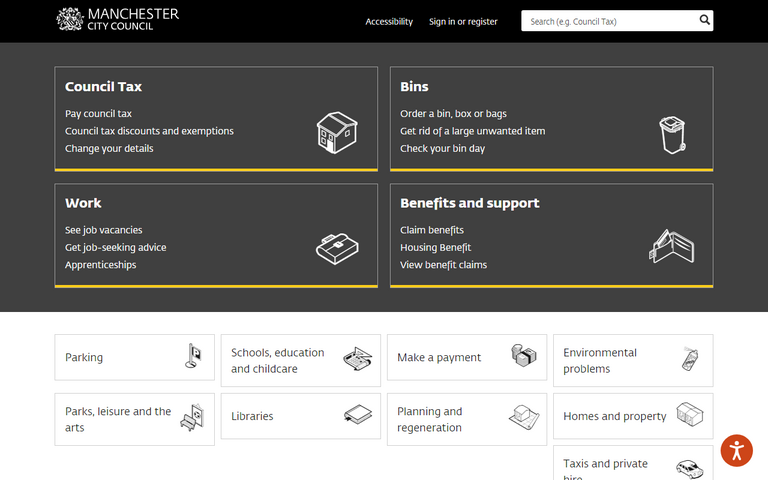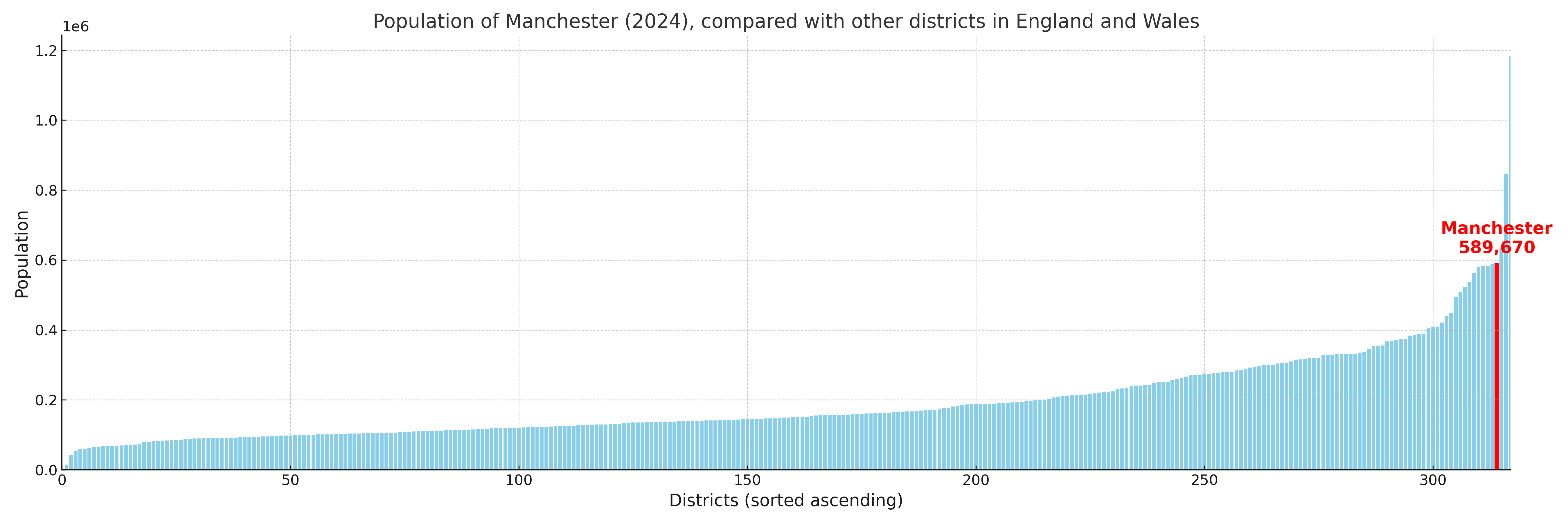Manchester
§ This page gives an overview of the Manchester local authority district, bringing together key facts, maps, and data to help you quickly understand the area. One of 361 district profiles on Baseview.
Overview ⁞ Manchester is a major city in North West England, famed for its industrial heritage, vibrant cultural scene, and iconic architecture. The city centre features landmarks such as Manchester Cathedral, the Town Hall in Albert Square, and modern developments like MediaCityUK and the Beetham Tower. The River Irwell and canals weave through historic warehouses now converted into apartments, galleries, and bars. Manchester is known for its music and sporting heritage, with venues like the AO Arena, Old Trafford, and Etihad Stadium. Green spaces include Heaton Park, one of Europe’s largest municipal parks, while surrounding neighbourhoods each bring distinctive character, from the Northern Quarter’s creativity to Didsbury’s leafy charm.
Manchester Boundary Map
This map shows the official boundary of the Manchester local authority district, based on the latest geographic data published by the Office for National Statistics (ONS). It provides a clear view of the district’s extent and helps you understand how the area fits within the wider regional and national landscape.
Contains OS data © Crown copyright and database right 2025. Source: Office for National Statistics licensed under the Open Government Licence v3.0.
The administrative boundary of Manchester can also be viewed on OpenStreetMap: District Boundary of Manchester.
Key Facts about Manchester
What region is Manchester in? Manchester is in the North West of England, a region within the UK.
What county is Manchester in? Manchester is located in the county of Greater Manchester.
Is Manchester a city? Yes, Manchester is a city. Manchester holds official city status as one of the 76 designated cities in the UK.
Who governs Manchester? The local government for this district is: Manchester City Council (Metropolitan District).
▶ Official website of Manchester City Council 🔗 manchester.gov.uk

Which police force covers Manchester? Policing in Manchester is provided by Greater Manchester Police 🔗 gmp.police.uk, which serves 10 local authority districts: Bolton ⁞ Bury ⁞ Manchester ⁞ Oldham ⁞ Rochdale ⁞ Salford ⁞ Stockport ⁞ Tameside ⁞ Trafford ⁞ Wigan.
Manchester in International Geographies
In the International Territorial Levels (ITLs) hierarchy, Manchester is within one of ITLs Level 2 area, Greater Manchester, that contains the following 5 ITLs Level 3 areas:
(ITL 1) North West
(ITL 2) ⇒ Greater Manchester
(ITL 3) ⇒⇒ Manchester ⁞ Greater Manchester South West ⁞ Greater Manchester South East ⁞ Greater Manchester North West ⁞ Greater Manchester North East
The International Territorial Levels are used by OECD member countries for statistical purposes to classify administrative areas. We have this listable page for easy browsing of ITL names and codes: International Territorial Levels.
Constituencies in Manchester
Manchester is divided into 6 parliamentary constituencies, listed below in alphabetical order.
- Blackley and Middleton South
- Gorton and Denton
- Manchester Central
- Manchester Rusholme
- Manchester Withington
- Wythenshawe and Sale East
A constituency is a specific geographical area that elects one Member of Parliament (MP) to represent them in the House of Commons. The United Kingdom is divided into 650 parliamentary constituencies. We have this list page for easy browsing of all UK parliamentary constituencies: List of Constituencies.
Wards in Manchester
Manchester is divided into 32 wards, listed below in alphabetical order.
- Ancoats & Beswick
- Ardwick
- Baguley
- Brooklands
- Burnage
- Charlestown
- Cheetham
- Chorlton
- Chorlton Park
- Clayton & Openshaw
- Crumpsall
- Deansgate
- Didsbury East
- Didsbury West
- Fallowfield
- Gorton & Abbey Hey
- Harpurhey
- Higher Blackley
- Hulme
- Levenshulme
- Longsight
- Miles Platting & Newton Heath
- Moss Side
- Moston
- Northenden
- Old Moat
- Piccadilly
- Rusholme
- Sharston
- Whalley Range
- Withington
- Woodhouse Park
In the UK, a ward is a subdivision of a local authority area, used mainly for electoral and statistical purposes. Defined by the ONS, wards represent the primary unit for local elections, each returning one or more councillors to the local council. Wards are also used as a key geography for presenting population and census data.
Parishes in Manchester
Manchester is part-parished: 1 civil parishes (listed A-Z below) alongside 7 unparished areas.
- Ringway
A civil parish is the lowest tier of local government in England, used for villages, small towns, and suburbs. They have their own local authority, either a parish council or a parish meeting, which provides local services like managing parks, allotments, and streetlights, and represents the community's views to larger councils.
Built-up Areas in Manchester
Manchester covers 19 built-up areas, listed below in alphabetical order.
- Altrincham *
- Audenshaw *
- Chadderton *
- Denton (Tameside) *
- Droylsden *
- Failsworth *
- Gatley *
- Hale (Trafford) *
- Manchester *
- Middleton (Rochdale) *
- Old Trafford *
- Prestwich *
- Reddish *
- Rhodes *
- Sale *
- Salford *
- Stockport *
- Stretford *
- Wythenshawe *
In the UK, a Built-up Area (BUA) is a continuous urban area of at least 20 hectares (0.2 km²), defined by the ONS as land where buildings are generally no more than 200 metres apart, such as towns, cities, or large villages. (Note: A BUA name marked with an asterisk (*) indicates that the area is situated partly in the district of Manchester.)
Manchester compared with other districts in the UK
This section shows how Manchester compares with other local authority districts in the UK, using a variety of measures and rankings.
Manchester has 32 electoral wards.

Manchester has a population of 589,670 (2024 mid-year estimate by ONS)

More local statistics and data for Manchester can be found on the ONS statistics for Manchester.